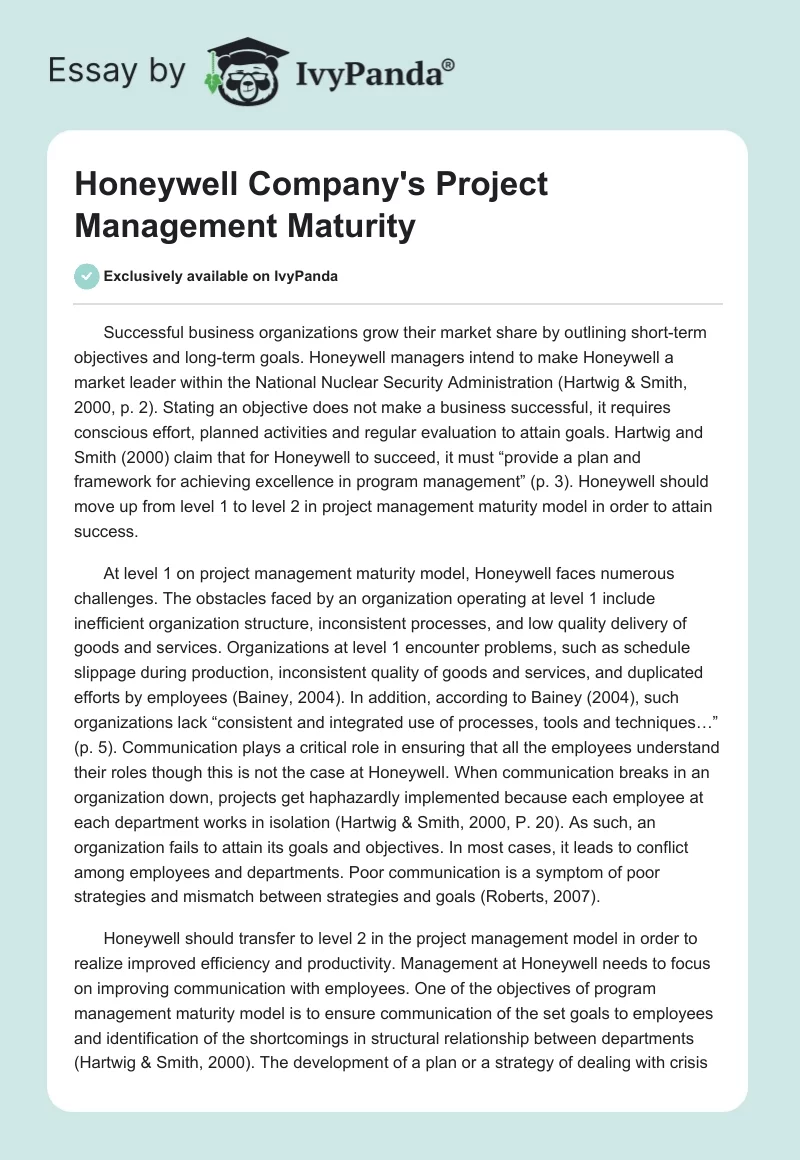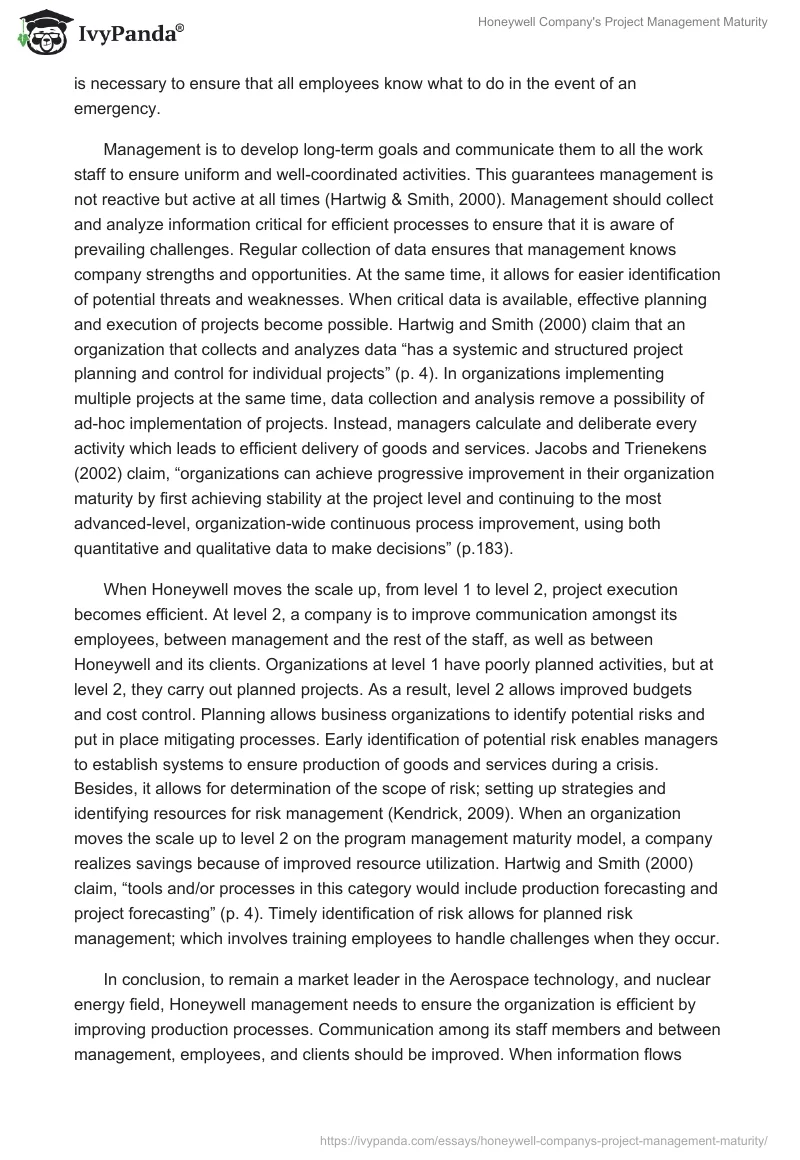Successful business organizations grow their market share by outlining short-term objectives and long-term goals. Honeywell managers intend to make Honeywell a market leader within the National Nuclear Security Administration (Hartwig & Smith, 2000, p. 2). Stating an objective does not make a business successful, it requires conscious effort, planned activities and regular evaluation to attain goals. Hartwig and Smith (2000) claim that for Honeywell to succeed, it must “provide a plan and framework for achieving excellence in program management” (p. 3). Honeywell should move up from level 1 to level 2 in project management maturity model in order to attain success.
At level 1 on project management maturity model, Honeywell faces numerous challenges. The obstacles faced by an organization operating at level 1 include inefficient organization structure, inconsistent processes, and low quality delivery of goods and services. Organizations at level 1 encounter problems, such as schedule slippage during production, inconsistent quality of goods and services, and duplicated efforts by employees (Bainey, 2004). In addition, according to Bainey (2004), such organizations lack “consistent and integrated use of processes, tools and techniques…” (p. 5). Communication plays a critical role in ensuring that all the employees understand their roles though this is not the case at Honeywell. When communication breaks in an organization down, projects get haphazardly implemented because each employee at each department works in isolation (Hartwig & Smith, 2000, P. 20). As such, an organization fails to attain its goals and objectives. In most cases, it leads to conflict among employees and departments. Poor communication is a symptom of poor strategies and mismatch between strategies and goals (Roberts, 2007).
Honeywell should transfer to level 2 in the project management model in order to realize improved efficiency and productivity. Management at Honeywell needs to focus on improving communication with employees. One of the objectives of program management maturity model is to ensure communication of the set goals to employees and identification of the shortcomings in structural relationship between departments (Hartwig & Smith, 2000). The development of a plan or a strategy of dealing with crisis is necessary to ensure that all employees know what to do in the event of an emergency.
Management is to develop long-term goals and communicate them to all the work staff to ensure uniform and well-coordinated activities. This guarantees management is not reactive but active at all times (Hartwig & Smith, 2000). Management should collect and analyze information critical for efficient processes to ensure that it is aware of prevailing challenges. Regular collection of data ensures that management knows company strengths and opportunities. At the same time, it allows for easier identification of potential threats and weaknesses. When critical data is available, effective planning and execution of projects become possible. Hartwig and Smith (2000) claim that an organization that collects and analyzes data “has a systemic and structured project planning and control for individual projects” (p. 4). In organizations implementing multiple projects at the same time, data collection and analysis remove a possibility of ad-hoc implementation of projects. Instead, managers calculate and deliberate every activity which leads to efficient delivery of goods and services. Jacobs and Trienekens (2002) claim, “organizations can achieve progressive improvement in their organization maturity by first achieving stability at the project level and continuing to the most advanced-level, organization-wide continuous process improvement, using both quantitative and qualitative data to make decisions” (p.183).
When Honeywell moves the scale up, from level 1 to level 2, project execution becomes efficient. At level 2, a company is to improve communication amongst its employees, between management and the rest of the staff, as well as between Honeywell and its clients. Organizations at level 1 have poorly planned activities, but at level 2, they carry out planned projects. As a result, level 2 allows improved budgets and cost control. Planning allows business organizations to identify potential risks and put in place mitigating processes. Early identification of potential risk enables managers to establish systems to ensure production of goods and services during a crisis. Besides, it allows for determination of the scope of risk; setting up strategies and identifying resources for risk management (Kendrick, 2009). When an organization moves the scale up to level 2 on the program management maturity model, a company realizes savings because of improved resource utilization. Hartwig and Smith (2000) claim, “tools and/or processes in this category would include production forecasting and project forecasting” (p. 4). Timely identification of risk allows for planned risk management; which involves training employees to handle challenges when they occur.
In conclusion, to remain a market leader in the Aerospace technology, and nuclear energy field, Honeywell management needs to ensure the organization is efficient by improving production processes. Communication among its staff members and between management, employees, and clients should be improved. When information flows properly, misunderstandings do not arise. Management is to arrange for regular training of employees as well as hire skilled people. Finally, control of cost, and management of risk play a crucial role in ensuring Honeywell remains a market leader.
Reference List
Bainey, K. (2004). Integrated IT Project Management: A Model-Centric Approach. Norwood: Artech House Inc.
Jacobs, J. & Trienekens, J. (2002). Towards a metrics based verification and validation maturity model. In Computer Safety, Reliability and Security: Proceedings of 21st International Conference, SAFECOMP 2002, held 10-13 September 2002 at Catania, Italy (pp. 175-186). New York: Springer.
Hartwig, L., and Smith, M. (2000). Honeywell FM & T – Project Management Maturity Model: Development and Implementation of Program Management Maturity Model. Web.
Kendrick, T. (2009). Identifying and Managing Project Risk: Essential tools for Failure-Proofing your Project. New York: AMACOM.
Roberts, P. (2007). Guide to Project Management: Achieving Lasting Benefits through Effective Change. London: Profile Books Ltd.


